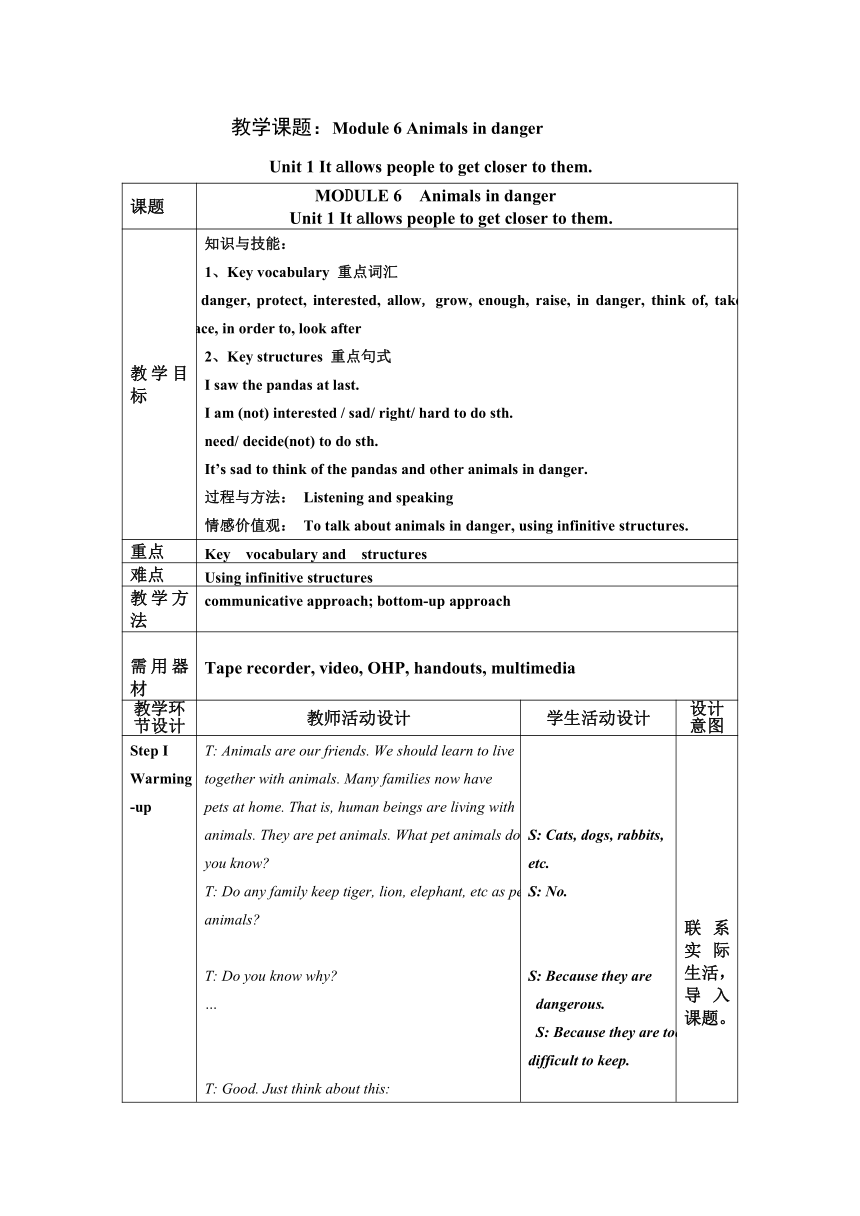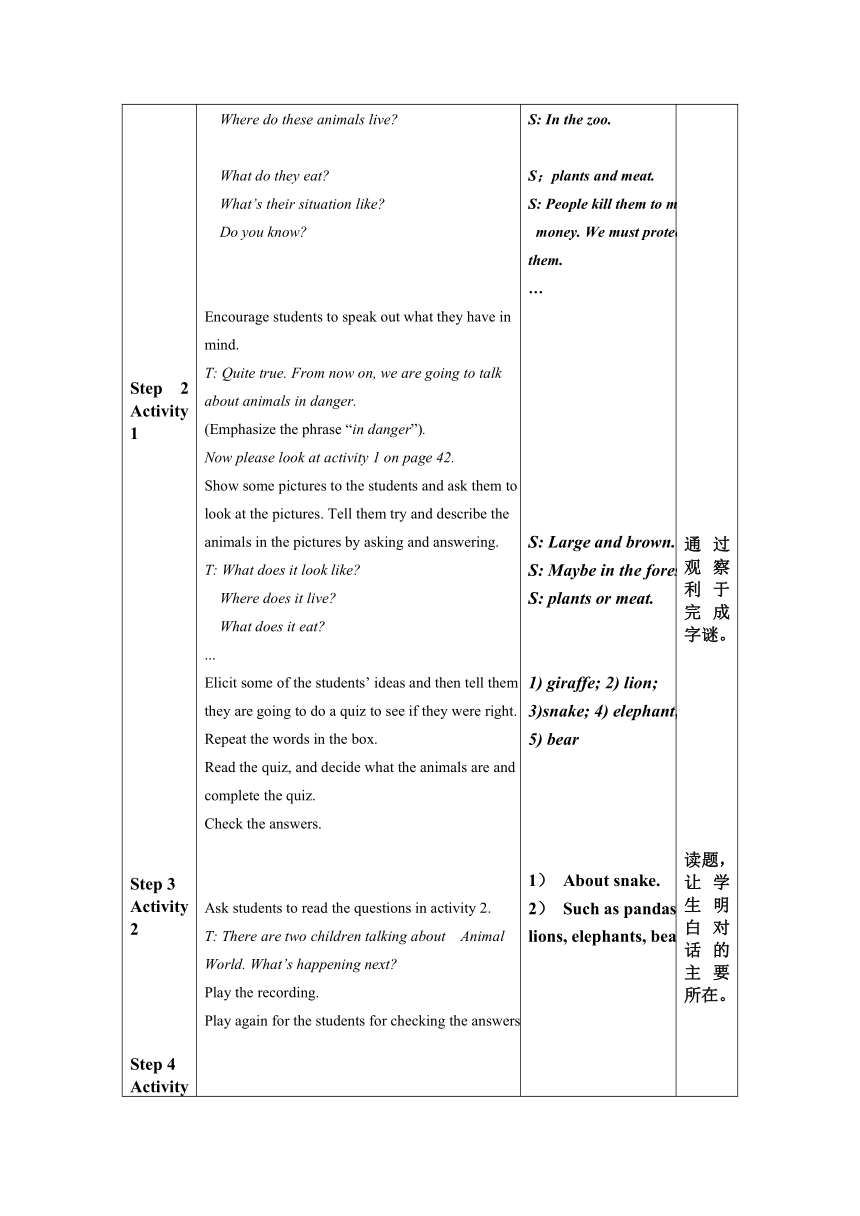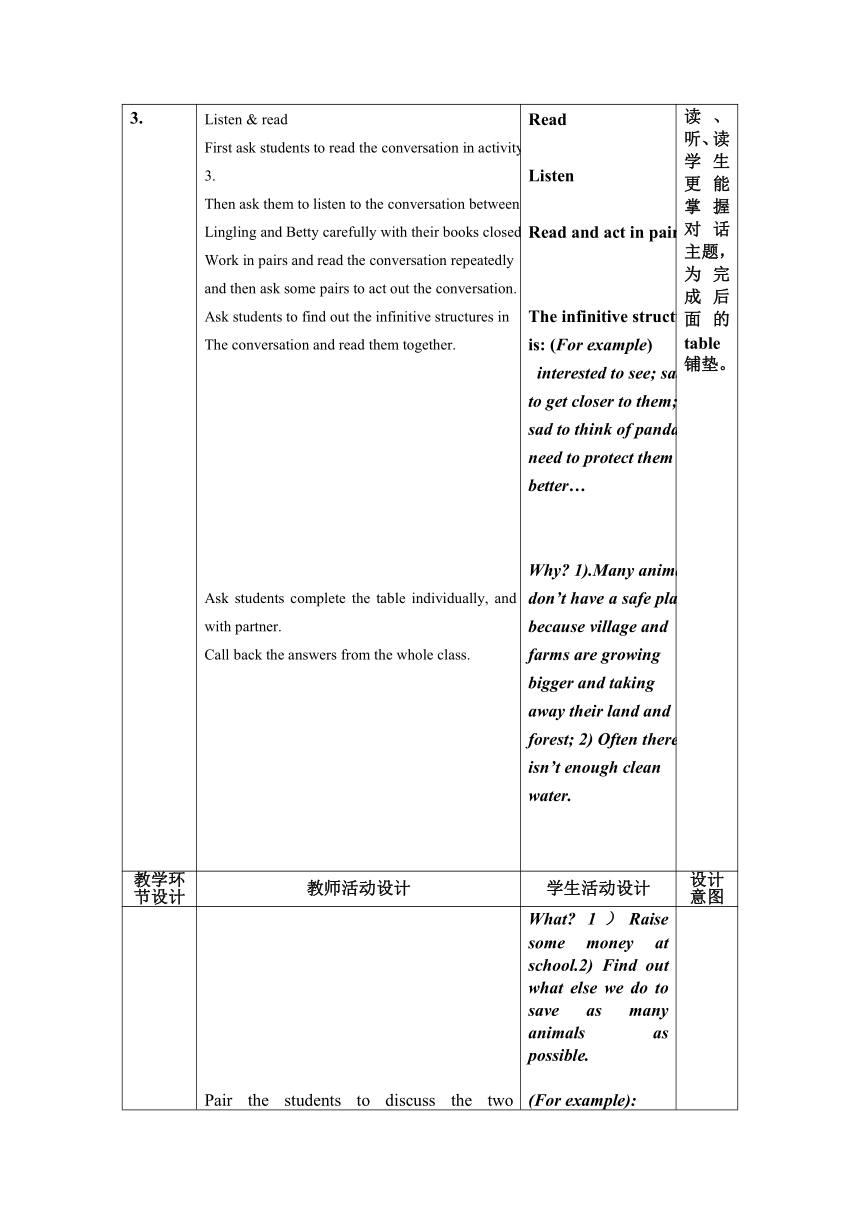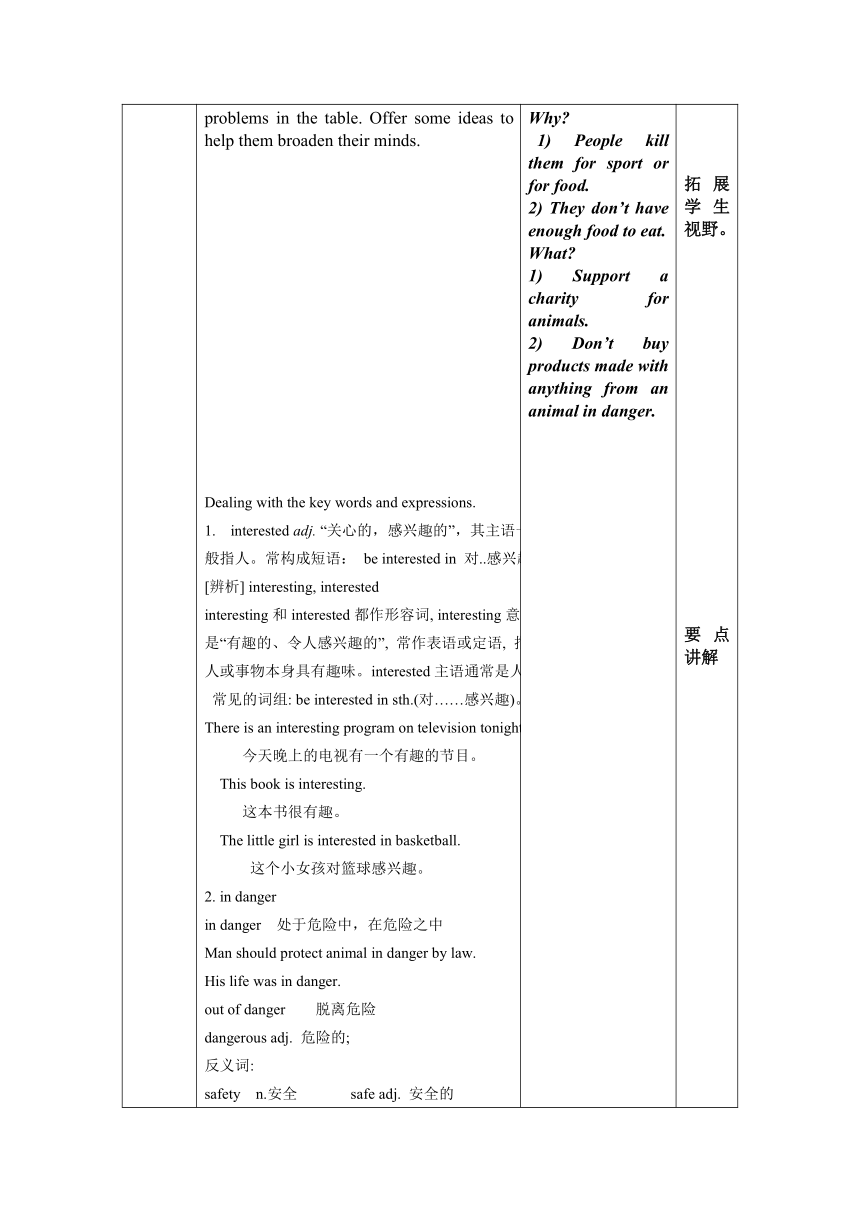外研版八年级上册教案Module 6 Animals in danger Unit1 It allows people to get closer to them
文档属性
| 名称 | 外研版八年级上册教案Module 6 Animals in danger Unit1 It allows people to get closer to them |  | |
| 格式 | zip | ||
| 文件大小 | 23.8KB | ||
| 资源类型 | 教案 | ||
| 版本资源 | 外研版 | ||
| 科目 | 英语 | ||
| 更新时间 | 2016-11-15 13:12:58 | ||
图片预览




文档简介
教学课题:Module
6
Animals
in
danger
Unit
1
It
allows
people
to
get
closer
to
them.
课题
MODULE
6
Animals
in
dangerUnit
1
It
allows
people
to
get
closer
to
them.
教学目标
知识与技能:
1、Key
vocabulary
重点词汇
danger,
protect,
interested,
allow,
grow,
enough,
raise,
in
danger,
think
of,
take
away,
in
peace,
in
order
to,
look
after2、Key
structures
重点句式
I
saw
the
pandas
at
last.I
am
(not)
interested
/
sad/
right/
hard
to
do
sth.need/
decide(not)
to
do
sth.It’s
sad
to
think
of
the
pandas
and
other
animals
in
danger.
过程与方法:
Listening
and
speaking情感价值观:
To
talk
about
animals
in
danger,
using
infinitive
structures.
重点
Key
vocabulary
and
structures
难点
Using
infinitive
structures
教学方法
communicative
approach;
bottom-up
approach
需用器材
Tape
recorder,
video,
OHP,
handouts,
multimedia
教学环节设计
教师活动设计
学生活动设计
设计意图
Step
I
Warming-up
Step
2
Activity
1Step
3Activity
2Step
4Activity
3.
T:
Animals
are
our
friends.
We
should
learn
to
livetogether
with
animals.
Many
families
now
havepets
at
home.
That
is,
human
beings
are
living
with
animals.
They
are
pet
animals.
What
pet
animals
doyou
know T:
Do
any
family
keep
tiger,
lion,
elephant,
etc
as
pet
animals T:
Do
you
know
why …T:
Good.
Just
think
about
this:
Where
do
these
animals
live
What
do
they
eat
What’s
their
situation
like
Do
you
know
Encourage
students
to
speak
out
what
they
have
in
mind.
T:
Quite
true.
From
now
on,
we
are
going
to
talk
about
animals
in
danger.
(Emphasize
the
phrase
“in
danger”).
Now
please
look
at
activity
1
on
page
42.
Show
some
pictures
to
the
students
and
ask
them
to
look
at
the
pictures.
Tell
them
try
and
describe
the
animals
in
the
pictures
by
asking
and
answering.T:
What
does
it
look
like
Where
does
it
live
What
does
it
eat ...Elicit
some
of
the
students’
ideas
and
then
tell
themthey
are
going
to
do
a
quiz
to
see
if
they
were
right.Repeat
the
words
in
the
box.Read
the
quiz,
and
decide
what
the
animals
are
andcomplete
the
quiz.Check
the
answers.Ask
students
to
read
the
questions
in
activity
2.T:
There
are
two
children
talking
about
Animal
World.
What’s
happening
next Play
the
recording.Play
again
for
the
students
for
checking
the
answers.
Listen
&
read
First
ask
students
to
read
the
conversation
in
activity
3.
Then
ask
them
to
listen
to
the
conversation
betweenLingling
and
Betty
carefully
with
their
books
closed.Work
in
pairs
and
read
the
conversation
repeatedly
and
then
ask
some
pairs
to
act
out
the
conversation.
Ask
students
to
find
out
the
infinitive
structures
inThe
conversation
and
read
them
together.
Ask
students
complete
the
table
individually,
and
then
check
with
partner.Call
back
the
answers
from
the
whole
class.
S:
Cats,
dogs,
rabbits,
etc.
S:
No.S:
Because
they
are
dangerous.
S:
Because
they
are
too
difficult
to
keep.S:
In
the
zoo.S;plants
and
meat.S:
People
kill
them
to
make
money.
We
must
protect
them.…S:
Large
and
brown.S:
Maybe
in
the
forest.S:
plants
or
meat.1)
giraffe;
2)
lion;
3)snake;
4)
elephant;5)
bearAbout
snake.Such
as
pandas,lions,
elephants,
bears.ReadListenRead
and
act
in
pairs.The
infinitive
structuresis:
(For
example)
interested
to
see;
sad
to
get
closer
to
them;
sad
to
think
of
pandas;need
to
protect
them
better…Why
1).Many
animalsdon’t
have
a
safe
place
to
live,
because
village
and
farms
are
growing
bigger
and
taking
away
their
land
and
forest;
2)
Often
there
isn’t
enough
clean
water.
联系实际生活,导入课题。通过观察利于完成字谜。读题,让学生明白对话的主要所在。读、听、读学生更能掌握对话主题,为完成后面的table铺垫。
教学环节设计
教师活动设计
学生活动设计
设计意图
Step
5
Activity
4Step
6Activity
5Step
7
Activity
6
Pair
the
students
to
discuss
the
two
problems
in
the
table.
Offer
some
ideas
to
help
them
broaden
their
minds.Dealing
with
the
key
words
and
expressions.interested
adj.
“关心的,感兴趣的”,其主语一般指人。常构成短语:
be
interested
in
对..感兴趣。如:[辨析]
interesting,
interestedinteresting和interested都作形容词,
interesting意思是“有趣的、令人感兴趣的”,
常作表语或定语,
指人或事物本身具有趣味。interested主语通常是人,
常见的词组:
be
interested
in
sth.(对……感兴趣)。There
is
an
interesting
program
on
television
tonight.
今天晚上的电视有一个有趣的节目。
This
book
is
interesting.
这本书很有趣。
The
little
girl
is
interested
in
basketball.
这个小女孩对篮球感兴趣。2.
in
dangerin
danger
处于危险中,在危险之中
Man
should
protect
animal
in
danger
by
law.His
life
was
in
danger.out
of
danger
脱离危险dangerous
adj.
危险的;反义词:
safety
n.安全
safe
adj.
安全的3.
allowallow
允许;
许可,
具体用法:(1)
allow
(doing)
sth
允许(做)某事。如:
The
facts
allow
no
other
explanation.
事实不允许有其他的解释。
We
don’t
allow
eating
in
the
classrooms.
(我们)不允许在教室吃饭。
注:有时用于被动语态。如:
Dogs
are
not
allowed.
狗不得入内。
Smoking
is
not
allowed
here.
此处不准吸烟。(2)
allow
sb
to
do
sth
允许某人做某事。如:
My
parents
don’t
allow
me
to
go
out
at
night.
我父母不允许我晚上出去。
Her
boss
doesn’t
allow
her
to
use
the
telephone.
她的老板不允许她使用电话。
注:有时用于被动语态。如:
Passengers
are
not
allowed
to
smoke.
乘客不准吸烟。(3)
allow
sb
sth
给予某人某物(尤指钱或时间);让某人有(拥用或带有)某物。如:
He
allows
his
son
too
much
money.
他给他儿子的钱太多。
We’ll
allow
you
time
to
answer.
我们将给回答的时间。We
allow
passengers
one
item
of
hand
luggage
each.
我们允许每个乘客带一件手提行李。
注:有时用于被动语态。如:
I’m
not
allowed
visitors.
我不准有访客。4.
take
awaytake
away意为“把(东西)拿走;把(某人)带走”,可分开用。与take有关的词组有:
take
off
脱掉(衣服);(飞机)起飞
take
on
承担(工作,责任)
take
out
拿出;除去
take
care
小心
take
care
of
照料5.
enoughenough
adj.
足够的adv.充分地;足够地
I
haven't
enough
time
for
reading.
我没有足够的时间读书。
He
runs
fast
enough.
他跑得够快了。注:
enough作形容词时一般修饰名词,可放在名词前,也可放在其后;作副词时,常用来修饰形容词和副词,放在被修饰词的后面。[Practice](2011哈尔滨市)
The
young
man
is
_____
carry
that
heavy
bag.
A.
strong
enough
to
B.
enough
strong
to
C.
not
strong
enough
D.
strong
enough
答案:A6.
look
afterlook
after
照料
My
friend
looked
after
my
cat
while
I
was
on
holiday.
在我去度假的时候,我的朋友照料我的猫。
Robert's
old
enough
to
look
after
himself.
罗伯特这么大了,已经能照顾自己了。[拓展]look
back
(与
on,
to
连用)回想,记起
look
down
on
轻视,看不起
look
forward
to
盼望;期待
look
in
顺便看望;短暂访问
look
out
注意;当心!
look
at
看,
查看
考虑
look
for
寻找
期望
look
forward
to
盼望,
期待
look
like
看起来象
看来要
look
round
观光,
游览
look
through
浏览
look
up
and
down
仔细打量(某人);
到处寻找Tell
the
students
to
look
at
the
words
and
expression
in
the
box
and
predict
what
the
passage
is
about.Ask
them
to
complete
the
passage
and
check
whether
their
prediction
was
correct.Ask
them
to
complete
the
passage
individually
and
check
the
answers
in
pairs.Elicit
answers
from
the
whole
class.Ask
the
students
to
read
the
sentences
individually.Play
the
recording
for
them
to
listen
for
the
pronunciation
and
pauses.Play
again
and
pause
at
the
end
of
each
sentence
for
the
students
to
decide
where
the
speaker
pauses.Check
the
pauses
together.Play
the
recording
one
more
and
ask
them
to
repeat
chorally
and
individually
after
each
sentence.Nominate
some
students
to
read
out
the
sentences.
Remind
them
to
attention
to
the
pauses.Ask
the
students
to
read
the
question
individually.Put
them
in
pairs
to
ask
and
answer.
Encourage
them
to
say
what
they
really
think
and
tell
them
they
can
disagree
with
each
other.Tell
them
to
pick
up
any
errors
and
encourage
them
to
correct
themselves
when
they
ask
and
answer.
What
1)Raise
some
money
at
school.2)
Find
out
what
else
we
do
to
save
as
many
animals
as
possible.(For
example):Why
1)
People
kill
them
for
sport
or
for
food.2)
They
don’t
have
enough
food
to
eat.What
1)
Support
a
charity
for
animals.2)
Don’t
buy
products
made
with
anything
from
an
animal
in
danger.1.danger;
2.protect;
3.enough;
4.allows;
5.in
peace;6.raiseMark
the
pauses.Repeat.Sample
version:In
the
zoo;No.In
the
forest;Give
money
to
protect
the
animals.
拓展学生视野。要点讲解练句子的停顿,以矫正学生的说法。
板书设计
It
allows
people
to
get
closer
to
them.
练习设计
1.
托尼刚刚拿走了我的字典。Tony
______
_____
my
dictionary
just
now.2.
我有许多家务活要做。I
have
got
lots
of
housework
_____
______.3.
这位老人没地方住。The
old
man
has
_____
_____
_____
____
____.4.
老师已查明原因了。The
teacher
has
______
____
the
reasons.5.Retell
the
text
and
choose
a
kind
of
animal
to
describe
课后反思
Pandas●lion●snake●whale
●bear●tiger●elephant●…
In
danger!
↓①No
safe
and
enough
place
to
live;
②No
enough
clean
water.
↓
Need
to
protect:
①Protect
environment;
②Raise
money
toprotect
the
animals
↓
A
big
harmonious(和谐的)
world
6
Animals
in
danger
Unit
1
It
allows
people
to
get
closer
to
them.
课题
MODULE
6
Animals
in
dangerUnit
1
It
allows
people
to
get
closer
to
them.
教学目标
知识与技能:
1、Key
vocabulary
重点词汇
danger,
protect,
interested,
allow,
grow,
enough,
raise,
in
danger,
think
of,
take
away,
in
peace,
in
order
to,
look
after2、Key
structures
重点句式
I
saw
the
pandas
at
last.I
am
(not)
interested
/
sad/
right/
hard
to
do
sth.need/
decide(not)
to
do
sth.It’s
sad
to
think
of
the
pandas
and
other
animals
in
danger.
过程与方法:
Listening
and
speaking情感价值观:
To
talk
about
animals
in
danger,
using
infinitive
structures.
重点
Key
vocabulary
and
structures
难点
Using
infinitive
structures
教学方法
communicative
approach;
bottom-up
approach
需用器材
Tape
recorder,
video,
OHP,
handouts,
multimedia
教学环节设计
教师活动设计
学生活动设计
设计意图
Step
I
Warming-up
Step
2
Activity
1Step
3Activity
2Step
4Activity
3.
T:
Animals
are
our
friends.
We
should
learn
to
livetogether
with
animals.
Many
families
now
havepets
at
home.
That
is,
human
beings
are
living
with
animals.
They
are
pet
animals.
What
pet
animals
doyou
know T:
Do
any
family
keep
tiger,
lion,
elephant,
etc
as
pet
animals T:
Do
you
know
why …T:
Good.
Just
think
about
this:
Where
do
these
animals
live
What
do
they
eat
What’s
their
situation
like
Do
you
know
Encourage
students
to
speak
out
what
they
have
in
mind.
T:
Quite
true.
From
now
on,
we
are
going
to
talk
about
animals
in
danger.
(Emphasize
the
phrase
“in
danger”).
Now
please
look
at
activity
1
on
page
42.
Show
some
pictures
to
the
students
and
ask
them
to
look
at
the
pictures.
Tell
them
try
and
describe
the
animals
in
the
pictures
by
asking
and
answering.T:
What
does
it
look
like
Where
does
it
live
What
does
it
eat ...Elicit
some
of
the
students’
ideas
and
then
tell
themthey
are
going
to
do
a
quiz
to
see
if
they
were
right.Repeat
the
words
in
the
box.Read
the
quiz,
and
decide
what
the
animals
are
andcomplete
the
quiz.Check
the
answers.Ask
students
to
read
the
questions
in
activity
2.T:
There
are
two
children
talking
about
Animal
World.
What’s
happening
next Play
the
recording.Play
again
for
the
students
for
checking
the
answers.
Listen
&
read
First
ask
students
to
read
the
conversation
in
activity
3.
Then
ask
them
to
listen
to
the
conversation
betweenLingling
and
Betty
carefully
with
their
books
closed.Work
in
pairs
and
read
the
conversation
repeatedly
and
then
ask
some
pairs
to
act
out
the
conversation.
Ask
students
to
find
out
the
infinitive
structures
inThe
conversation
and
read
them
together.
Ask
students
complete
the
table
individually,
and
then
check
with
partner.Call
back
the
answers
from
the
whole
class.
S:
Cats,
dogs,
rabbits,
etc.
S:
No.S:
Because
they
are
dangerous.
S:
Because
they
are
too
difficult
to
keep.S:
In
the
zoo.S;plants
and
meat.S:
People
kill
them
to
make
money.
We
must
protect
them.…S:
Large
and
brown.S:
Maybe
in
the
forest.S:
plants
or
meat.1)
giraffe;
2)
lion;
3)snake;
4)
elephant;5)
bearAbout
snake.Such
as
pandas,lions,
elephants,
bears.ReadListenRead
and
act
in
pairs.The
infinitive
structuresis:
(For
example)
interested
to
see;
sad
to
get
closer
to
them;
sad
to
think
of
pandas;need
to
protect
them
better…Why
1).Many
animalsdon’t
have
a
safe
place
to
live,
because
village
and
farms
are
growing
bigger
and
taking
away
their
land
and
forest;
2)
Often
there
isn’t
enough
clean
water.
联系实际生活,导入课题。通过观察利于完成字谜。读题,让学生明白对话的主要所在。读、听、读学生更能掌握对话主题,为完成后面的table铺垫。
教学环节设计
教师活动设计
学生活动设计
设计意图
Step
5
Activity
4Step
6Activity
5Step
7
Activity
6
Pair
the
students
to
discuss
the
two
problems
in
the
table.
Offer
some
ideas
to
help
them
broaden
their
minds.Dealing
with
the
key
words
and
expressions.interested
adj.
“关心的,感兴趣的”,其主语一般指人。常构成短语:
be
interested
in
对..感兴趣。如:[辨析]
interesting,
interestedinteresting和interested都作形容词,
interesting意思是“有趣的、令人感兴趣的”,
常作表语或定语,
指人或事物本身具有趣味。interested主语通常是人,
常见的词组:
be
interested
in
sth.(对……感兴趣)。There
is
an
interesting
program
on
television
tonight.
今天晚上的电视有一个有趣的节目。
This
book
is
interesting.
这本书很有趣。
The
little
girl
is
interested
in
basketball.
这个小女孩对篮球感兴趣。2.
in
dangerin
danger
处于危险中,在危险之中
Man
should
protect
animal
in
danger
by
law.His
life
was
in
danger.out
of
danger
脱离危险dangerous
adj.
危险的;反义词:
safety
n.安全
safe
adj.
安全的3.
allowallow
允许;
许可,
具体用法:(1)
allow
(doing)
sth
允许(做)某事。如:
The
facts
allow
no
other
explanation.
事实不允许有其他的解释。
We
don’t
allow
eating
in
the
classrooms.
(我们)不允许在教室吃饭。
注:有时用于被动语态。如:
Dogs
are
not
allowed.
狗不得入内。
Smoking
is
not
allowed
here.
此处不准吸烟。(2)
allow
sb
to
do
sth
允许某人做某事。如:
My
parents
don’t
allow
me
to
go
out
at
night.
我父母不允许我晚上出去。
Her
boss
doesn’t
allow
her
to
use
the
telephone.
她的老板不允许她使用电话。
注:有时用于被动语态。如:
Passengers
are
not
allowed
to
smoke.
乘客不准吸烟。(3)
allow
sb
sth
给予某人某物(尤指钱或时间);让某人有(拥用或带有)某物。如:
He
allows
his
son
too
much
money.
他给他儿子的钱太多。
We’ll
allow
you
time
to
answer.
我们将给回答的时间。We
allow
passengers
one
item
of
hand
luggage
each.
我们允许每个乘客带一件手提行李。
注:有时用于被动语态。如:
I’m
not
allowed
visitors.
我不准有访客。4.
take
awaytake
away意为“把(东西)拿走;把(某人)带走”,可分开用。与take有关的词组有:
take
off
脱掉(衣服);(飞机)起飞
take
on
承担(工作,责任)
take
out
拿出;除去
take
care
小心
take
care
of
照料5.
enoughenough
adj.
足够的adv.充分地;足够地
I
haven't
enough
time
for
reading.
我没有足够的时间读书。
He
runs
fast
enough.
他跑得够快了。注:
enough作形容词时一般修饰名词,可放在名词前,也可放在其后;作副词时,常用来修饰形容词和副词,放在被修饰词的后面。[Practice](2011哈尔滨市)
The
young
man
is
_____
carry
that
heavy
bag.
A.
strong
enough
to
B.
enough
strong
to
C.
not
strong
enough
D.
strong
enough
答案:A6.
look
afterlook
after
照料
My
friend
looked
after
my
cat
while
I
was
on
holiday.
在我去度假的时候,我的朋友照料我的猫。
Robert's
old
enough
to
look
after
himself.
罗伯特这么大了,已经能照顾自己了。[拓展]look
back
(与
on,
to
连用)回想,记起
look
down
on
轻视,看不起
look
forward
to
盼望;期待
look
in
顺便看望;短暂访问
look
out
注意;当心!
look
at
看,
查看
考虑
look
for
寻找
期望
look
forward
to
盼望,
期待
look
like
看起来象
看来要
look
round
观光,
游览
look
through
浏览
look
up
and
down
仔细打量(某人);
到处寻找Tell
the
students
to
look
at
the
words
and
expression
in
the
box
and
predict
what
the
passage
is
about.Ask
them
to
complete
the
passage
and
check
whether
their
prediction
was
correct.Ask
them
to
complete
the
passage
individually
and
check
the
answers
in
pairs.Elicit
answers
from
the
whole
class.Ask
the
students
to
read
the
sentences
individually.Play
the
recording
for
them
to
listen
for
the
pronunciation
and
pauses.Play
again
and
pause
at
the
end
of
each
sentence
for
the
students
to
decide
where
the
speaker
pauses.Check
the
pauses
together.Play
the
recording
one
more
and
ask
them
to
repeat
chorally
and
individually
after
each
sentence.Nominate
some
students
to
read
out
the
sentences.
Remind
them
to
attention
to
the
pauses.Ask
the
students
to
read
the
question
individually.Put
them
in
pairs
to
ask
and
answer.
Encourage
them
to
say
what
they
really
think
and
tell
them
they
can
disagree
with
each
other.Tell
them
to
pick
up
any
errors
and
encourage
them
to
correct
themselves
when
they
ask
and
answer.
What
1)Raise
some
money
at
school.2)
Find
out
what
else
we
do
to
save
as
many
animals
as
possible.(For
example):Why
1)
People
kill
them
for
sport
or
for
food.2)
They
don’t
have
enough
food
to
eat.What
1)
Support
a
charity
for
animals.2)
Don’t
buy
products
made
with
anything
from
an
animal
in
danger.1.danger;
2.protect;
3.enough;
4.allows;
5.in
peace;6.raiseMark
the
pauses.Repeat.Sample
version:In
the
zoo;No.In
the
forest;Give
money
to
protect
the
animals.
拓展学生视野。要点讲解练句子的停顿,以矫正学生的说法。
板书设计
It
allows
people
to
get
closer
to
them.
练习设计
1.
托尼刚刚拿走了我的字典。Tony
______
_____
my
dictionary
just
now.2.
我有许多家务活要做。I
have
got
lots
of
housework
_____
______.3.
这位老人没地方住。The
old
man
has
_____
_____
_____
____
____.4.
老师已查明原因了。The
teacher
has
______
____
the
reasons.5.Retell
the
text
and
choose
a
kind
of
animal
to
describe
课后反思
Pandas●lion●snake●whale
●bear●tiger●elephant●…
In
danger!
↓①No
safe
and
enough
place
to
live;
②No
enough
clean
water.
↓
Need
to
protect:
①Protect
environment;
②Raise
money
toprotect
the
animals
↓
A
big
harmonious(和谐的)
world
同课章节目录
- Module 1 How to learn English
- Unit 1 Let's try to speak English as much as possi
- Unit 2 You should smile at her.
- Unit 3 Language in use .
- Module 2 My home town and my country
- Unit 1 It's taller than many other buildings.
- Unit 2 Cambridge is a beautiful city in the east o
- Unit 3 Language in use .
- Module 3 Sports.
- Unit 1 Nothing is more exciting than playing tenni
- Unit 2 This year we training more carefully.
- Unit 3 Language in use .
- Module 4 Planes, ships and trains .
- Unit 1 He lives the farthest from school.
- Unit 2 What is the best way to travel.
- Unit 3 Language in use .
- Module 5 Lao She Teahouse.
- Unit 1 I wanted to see the Beijing Opera.
- Unit 2 It descibes the changes in Chinese society.
- Unit 3 Language in use .
- Module 6 Animals in danger.
- Unit 1 It allows people to get closer to them .
- Unit 2 The WWF is working hard to save them all.
- Unit 3 Language in use .
- Revision module A
- Module 7 A famous story
- Unit 1 Alice was sitting with her sister by the ri
- Unit 2 She was thinking about her cat.
- Unit 3 Language in use .
- Module 8 Accidents
- Unit 1 While the car were changing to red, a car s
- Unit 2 I was trying to pick it up when it bite me
- Unit 3 Language in use .
- Module 9 Population
- Unit 1 The population of China is about 1.37 billi
- Unit 2 Arnwick was a city with 200,000 people.
- Unit 3 Language in use .
- Module 10 The weathe
- Unit 1 It might snow.
- Unit 2 The weather is fine all year round.
- Unit 3 Language in use .
- Module 11 Way of life
- Unit 1 In China ,we open a gift later.
- Unit 2 In England, you usually drink tea with milk
- Unit 3 Language in use .
- Module 12 Help
- Unit 1 What should we do before help arrives?
- Unit 2 Stay away from windows and heavy furniture.
- Unit 3 Language in use .
- Revision module B
